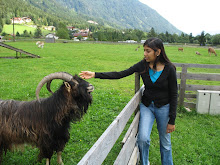I have seen whales in close proximity at the Sea World. But after watching the movie 'Whale Rider', I wished to see them in their natural environment. Just couple of months back, I picked this movie from the library and watched it for the second time, this time along with Mahesh. He too enjoyed the movie. We remembered this movie when we were in Hawaii and were trying to imitate some things from the movie :) It seems mid-December to April is the whale season in Hawaii. We were in January, therefore we managed to see some of them. We came across several couples - the mother whales along with their calves. By the way, we went for a whale watch with the non-profit Pacific Whale foundation in Maui; they took us in catamarans powered with biodisel. We were also able to listen to the whales' songs via the
underwater hydrophones. We came across some common whale behaviors such as a blow, peduncle arch, fluke up drive or pec slap (see pictures below) but unfortunately not a breach, spy hop, peduncle throw, head slap or tail slap.
Pacific Whale Foundation

Mother and calf

Peduncle arch

Pec slap

Here are some of the interesting facts on humpback whales that I learnt from the trip.
About 8000 humpback whales travel more than 2500 miles from Alaska to Hawaii, one of the longest migrations in the animal kingdom. Humpback whales spend winters in Hawaii where they mate, give birth and care for their young. They spend summer in Alaska where they engage in feeding on small fishes which are found dense in Alaska. Their throats are so small that they cannot swallow anything larger than a grapefruit. Moreover, they do not have teeth, instead they have 300 to 400 long rigid strips called baleen (similar to human fingernails). The gestation period of a humpback whale is 11.5 months. They are both conceived and born in Hawaii. The calves are 13 to 15 feet at birth and weigh 1.5 to 2 tons. The adults are 42 to 45 feet and weigh 35 to 40 tons. Males engage in singing; they do not have vocal cords, these sounds are produced by various valves and muscles within the respiratory tract.
It is heartbreaking when I come across the video shots on whaling. Whaling is still practiced by Norway, Japan and Iceland. Click here for more about whaling.

No comments:
Post a Comment